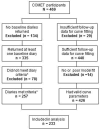Visual activity and its association with myopia stabilisation
- PMID: 24345071
- PMCID: PMC3999267
- DOI: 10.1111/opo.12111
Visual activity and its association with myopia stabilisation
Abstract
Purpose: To evaluate the association between outdoor and nearwork activities at baseline and myopia stabilisation by age 15 in the Correction of Myopia Evaluation Trial (COMET).
Methods: Correction of Myopia Evaluation Trial enrolled 469 children (ages: 6-11 years) with spherical equivalent myopia between -1.25 and -4.50 D, who were randomised to progressive addition or single vision lenses and followed for 5 years in their original lenses. At baseline, families recorded the child's outdoor and nearwork activities for 3 days within a week. Weekly hours spent in nearwork and outdoor activities were calculated for each participant. Refractions collected over 11 years were fit using the Gompertz function to determine each participant's myopia stabilisation age. Myopia for each child was then categorized as stable/not stable by age 15.
Results: Half (233/469) of participants had usable baseline activity diaries and refraction data that could be fit with the Gompertz function, 59.7% (139/233) had stable myopia by age 15 and 40.3% had myopia that was not yet stable. The frequency of stable myopia was similar for the two categories (median split) of outdoor activities: 60% (71/118) for ≤9.0 hours/week(-1) and 59% (68/115) for >9.0 hours/week(-1) . 56% (64/114) of children reporting >21.0 h of baseline weekly nearwork activity had stable myopia by age 15 compared to 63% (75/119) with ≤21.0 h of near work (adjusted OR = 0.74; 95% CI: 0.43-1.29). Using baseline nearwork as a continuous variable, the multivariable odds ratio for the association between baseline nearwork hours and stabilisation by age 15 is 0.98: 95% CI: 0.96-1.00, a result trending towards significance.
Conclusion: While time spent in outdoor activities in childhood does not appear to be related to myopia stabilisation by age 15, less near work activity might potentially be associated with myopia stabilisation by that age.
Keywords: myopia; nearwork; outdoor activity; visual activity.
© 2013 The Authors Ophthalmic & Physiological Optics © 2013 The College of Optometrists.
References
-
- Lin LL, Shih YF, Hsiao CK, Chen CJ. Prevalence of myopia in Taiwanese schoolchildren: 1983 to 2000. Ann Acad Med Singapore. 2004;33:27–33. - PubMed
-
- Vitale S, Sperduto RD, Ferris FL., 3rd Increased prevalence of myopia in the United States between 1971-1972 and 1999-2004. Arch Ophthalmol. 2009;127:1632–1639. - PubMed
-
- Fan DS, Lam DS, Lam RF, et al. Prevalence, incidence, and progression of myopia of school children in Hong Kong. Invest Ophthalmol Vis Sci. 2004;45:1071–1075. - PubMed
-
- Saw SM, Gazzard G, Shih-Yen EC, Chua WH. Myopia and associated pathological complications. Ophthalmic Physiol Opt. 2005;25:381–391. - PubMed
Publication types
MeSH terms
Grants and funding
- P30 EY007551/EY/NEI NIH HHS/United States
- U10 EY011752/EY/NEI NIH HHS/United States
- EY11756/EY/NEI NIH HHS/United States
- U10 EY011805/EY/NEI NIH HHS/United States
- U10 EY011755/EY/NEI NIH HHS/United States
- EY11752/EY/NEI NIH HHS/United States
- U10 EY011754/EY/NEI NIH HHS/United States
- EY11754/EY/NEI NIH HHS/United States
- EY11805/EY/NEI NIH HHS/United States
- EY11755/EY/NEI NIH HHS/United States
- EY11740/EY/NEI NIH HHS/United States
- U10 EY014713/EY/NEI NIH HHS/United States
- U10 EY011740/EY/NEI NIH HHS/United States
- U10 EY011756/EY/NEI NIH HHS/United States
LinkOut - more resources
Full Text Sources
Other Literature Sources



